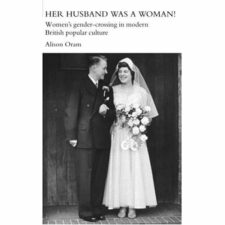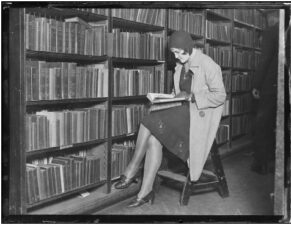On 13 and 14 April, the University of Newcastle hosted the conference ‘Moving Dangerously: Women and Travel, 1850-1950’. Organised by Dr Emma Short, two keynote addresses and eighteen parallel sessions held participants entranced, enlivened and enthused. Literature graduates and academics predominated. At the same time, an interdisciplinary flavour was much in evidence, through the literary theme’s being interspersed with papers presented by graduates, academics and practitioners in film, history, geography, anthropology, engineering and law. Air travel and travel by boat, riding on camels and bicycles, motoring and travelling by tube, taking buses and trains locally, venturing abroad in urban and metropolitan climes, or internationally – women were revealed as intrepid travellers, sometimes itinerant, often times perpetual. The dangers of travel and the notion of women as dangerous travellers were explored, along with women as initiators of travel, as inventors and designers of many modes of travel, and women as everything other than ‘only’ ‘armchair travellers’ filled two intense days of presentations, discussions and debates.
Participation in the conference confirmed that women remain committed to travel – by whatever means available. Women came from London, Newcastle, Germany, Canada, the United States, Scotland,Portugal and Madeira, Sweden, Spain, The Netherlands, Canary Islands, Australia, Poland, Switzerl, Italy, Wales – and north, south, west, east and central England. A plethora of universities was represented, as well as independent scholars contributing.
Avril Maddrell of the Universityof West England and Alexandra Peat of Franklin College, Switzerland presented keynote addresses. In ‘Women on the Move: Moving and Being Moved’, Dr Maddrell opened the conference, bringing a lyrical dimension to the notion and the reality of women travelling and women as travellers. Moving from place to place engages the traveller in ‘seeing the sights’ as well as ‘feeling’ them. Feeling and feelings are integral to the experience of travel, with women’s writing on and of their travels being incorporated into Dr Maddrell’s presentation to illustrate the travel experience as seen through women’s eyes, as heard and as felt by women’s bodies and women’s brains both physically and emotionally.
This setting of the scene was enhanced by Associate Professor Peat on the second day, when she took travelling to another dimension, in ‘The Limitless Horizon: Travelling in the Home’. The idea that the woman at home is nothing but ‘of the home’ was contested by reference to travel artifacts in the home; through furnishings as redolent of places far away – as in drapes and couches, wall hangings and bedding; by use o f cooking utensils such as the wok and bain-marie; so, too, styles of cooking and kitchen, breads and beverages. The challenge of the exotic nature of what is so often classed as ‘domestic’, together with the concept of the window as a ‘window to the world’ whilst also being a window into the world, affirmed both the vitality and the importance of seeing anew.
The renunciation of the tendency to be accepting of old, established ways of seeing was replicated in panel presentations. As is always the case, choice was difficult. The first day saw participants having to decide between ‘Middle Eastern Journeys’, ‘African Adventures’ and ‘Extreme Movements’, with the afternoon being a question of whether to attend ‘Class, Femininity and Travel’, ‘Empire and Travel’ or ‘Emancipatory Movements’, and, later, ‘Transatlantic Travels’, ‘Travel in the Press’ or ‘Movement Through Film’. For day two, decisions were equally complicated, with morning panels on ‘Modernist Movement I’, ‘Crossing the Boundaries of Eastern Europe’ and ‘Automotive Travel’, then ‘Autobiography and the Travelogue’, ‘Anthropology and/as Travel or ‘Politics and War’. The afternoon required decisions as to attending ‘Moving Through London’, ‘National Identity and Travel’ or ‘Modernist Movement II’.
Referring to some presentations rather than others presents as many conundrums, for even as to those sessions it was impossible to attend, the vigour of exchanges over coffee and tea, lunch, drinks and dinner was indicative of the high benchmark reached by all presenting and the content of all presentations. Nevertheless, for two that stepped outside the literary theme, Emma Baumhofer’s ‘On the Road: Passing Women inAmerica, 1890-1910’ and Nina Baker’s ‘Women Car Designers and Designing Cars for Women: The Arrol Galloway and the Volvo YCC’ were notable. An engineer, Baker looked at ‘designing women’ from the turn of the last century, illustrating her presentation with images of early motorised carriages which were not built to accommodate full skirts, yet which women drove, anyway, as well as contributing significantly to car design in those early days. Baker spoke, too, of the Volvo all-woman team which, although wrongly presented as a ‘first’ in terms of women car-designers, developed a prototype from which Volvo incorporated particular aspects and which remain integral to some Volvo models. In a completely different approach to ‘travel’, Baumhofer took as her focus women who ‘passed’ as men – taking men’s jobs, drinking in ‘all-male’ bars, swearing and gambling, marrying as men and being discovered, sometimes, only upon death. Women masqueraded as sailors, soldiers, pirates; worked in factories – as hard and as long as the men; changed names, identities and locations; and were the subject of scandal upon being ‘outed’ – whether alive or dead.
Meanwhile – one of the literary contributions to the conference, Ellen Turner’s ‘EM Hull’s Camping in the Sahara: Desert Romance Meets Desert Reality’ provided an insight into a woman-of-mystery of another kind. EM Hull’s famous sheik novels made both her and Rudolph Valentino famous – Hull for her graphic scenes of love-in-the-desert, Valentino for his depiction of Hull’s sheik who loves-in-the-desert. Hull’s pig-farmer husband simply ‘got on with it’ down on the farm, whilst Hull – and later she and their daughter – travelled the desert sands in (part at least) emulation of Hull’s heroines.
‘Love and romance’ in the context of travel and woman’s place was an element of two presentations on film, too. Andrew Hogan’s ‘Red Women on the Move: Soviet Representations of Women Travelling, 1925-35’ and Anna C. Sloan’s ‘Virgins inItaly: Tourism, Imperialism, and the American Women in 1950s Hollywood Melodrama’ sparked lively debate around the presentation and representation of women through film. Presenters and participants engaged in a thoughtful exchange on the role of ‘the journey’ both as figurative and literal cinema archetype in films featuring women protagonists, taking women forward in self-development, -confidence and -esteem, and ways in which that journey may be enhanced by travel into previously unknown climes.
In travelling, women show themselves to be brave and courageous, intrepid and innovative, inquisitive and, sometimes, supremacist, racist and even, perhaps, unbearable. ‘Moving Dangerously: Women and Travel, 1850-1950’ brought home so clearly the importance of exploring and affirming the many dimensions of women and women’s lives, all over the world.
Note: The conference programme in its entirety, including all titles of papers and presenters, may be found on the University of Newcastle website.
Dr Jocelynne A. Scutt’s books include No Fear of Flying – Women at Home and Abroad, one of twelve volumes in the ‘Women’s Voices, Women’s Lives’ series which contains autobiography by women of a broad range of backgrounds, ages and identities.

